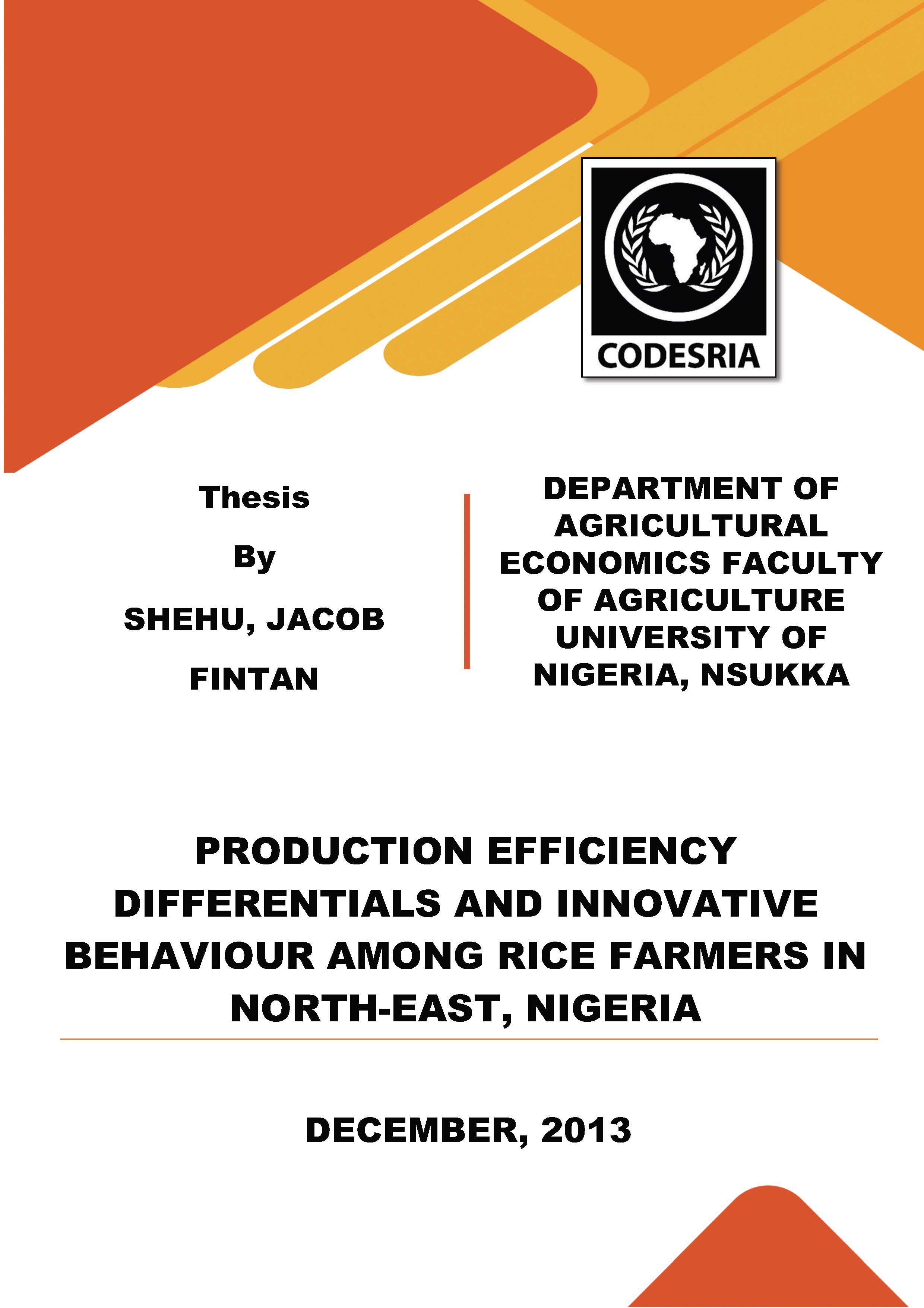PRODUCTION EFFICIENCY DIFFERENTIALS AND INNOVATIVE BEHAVIOUR AMONG RICE FARMERS IN NORTH-EAST, NIGERIA
Keywords:
PRODUCTION, INNOVATIVE BEHAVIOUR, RICE FARMERS, NIGERIASynopsis
This study empirically investigated production efficiency differentials and adoption behaviour among rice producers in North-East, Nigeria. The specific objectives were to analyze the socioeconomic and production factors of the rice farmers in the region; measure technical (TE), allocative (AE) and economic (EE) efficiencies of the farmers under traditional and modern
production technologies; identify the determinants of TE, AE and EE of the sampled rice farmers; identify factors that influence the adoption of modern production technologies by the rice farmers; and identify constraints associated with rice production in the study area. Data for the study was collected from a sample of 270 rice farmers whose responses were sought on their production activities. Descriptive statistics, Stochastic Frontier Production and Cost Functions, tobit regression and Logistic regression were used in analyzing the data. Results revealed that adopters of modern rice production technologies obtained higher average yield than the nonadopters. The difference between the yields is substantial as attested by the significance of tvalue at 1% level. However, there were no significant differences between adopters and nonadopters in terms of age, household size and farming experience. The FRONTIER result showed that the mean TE, AE and EE were 69.1%, 66.1%, 37.6% and 67.6%, 30.3%, 22.4%, respectively for adopters and non-adopters. The tobit result identified family size, education, extension contact, access to credit and system of land ownership as determinants of efficiency. The logistic regression result indicated that farm income, access to information, access to credit, education level of household head, family size and membership of cooperative society played significant role in the influencing farmers’ adoption behaviour. Inaccessibility to cheap farm inputs, inadequate rainfall, and conflict with grazing nomads among others were identified as the major problems faced by the sampled farmers. The study concluded that there is substantial difference in the levels of production inefficiencies among the sampled rice farmers; and access to information, literacy level and membership of cooperative society significantly influenced the adoption behaviour of the farmers. The study therefore, recommended that the agricultural extension programme should be revitalized. Additionally, farmers should organize themselves into viable cooperative groups to take advantage of economies of scale in bulk purchase of inputs at subsidized rates.
Downloads
References
FAOSTAT (2013) Online Database, Accessed 17th December, 2013, http://faostat.fao.org/, Food and Agriculture Organization of the United Nations, Rome.
Färe, R. S. and C. A. K. Lovell (1978). Measuring the Technical Efficiency of Production, Journal of Economic Theory, 19: 150-162.
Färe, R., S. Grosskopf and C. A. K. Lovell (1985). The Measurement of Efficiency of Production, Kluwer-Nijhoff Publishing, Boston.
Färe, R., S. Grosskopf and C. A. K. Lovell (1994). Production Frontiers, Cambridge University Press, Cambridge.
Farrel, M. J. (1957). The Measurement of Production Efficiency, Journal of Royal Statistical Society Series A,120: 253-281.
Feder, G. (1982). Adoption of Interrelated Agricultural Innovations: Complementarity and Impact of Risk, Scale and Credit, American Journal of Agricultural Economics, 64(1): 94-101.
Feder, G. and D. Umali (1993). The Adoption of Agricultural Innovations: A Review, Technological, Forecasting and Social Change, 43: 215-239.
Feder, G. and G. O’mara (1981). Farm Size and the Diffusion of Green Revolution Technology, Economic Development and Cultural Change, 33: 255-298.
Feder, G. and G. O’mara (1982). On Information and Innovation Diffusion: A Bayesian Approach, American Journal of Agricultural Economics, 6: 141-145.
Feder, G., R. E. Just and D. Zilberman (1985). Adoption of Agricultural Innovations in Developing Countries: A Survey, Economic Development and Cultural Change, 33: 255-298.
Federal Republic of Nigeria, FRN (2007). Official Gazette, No.24 vol.94, Federal Government Printer, Lagos, Nigeria.
Food and Agriculture Organization, FAO (2001a). The Economics of Conservation Agriculture, Food and Agriculture Organization of the United Nations, Rome.
Food and Agriculture Organization, FAO (2001b). Economics of Soil Productivity in Sub-Saharan Africa, Food and Agriculture Organization of the United Nations, Rome.
Forsund, F. and E. Jansen (1977). On Estimating Average and Best Practice Homothetic Production Functions via Cost Function, International Economic Review, 18: 463-476.
Forsund, F. R. and L. Hajilmarsson (1979). Generalized Farrell’s Measures of Efficiency, Swedish Journal of Economics, 70:141-154.






